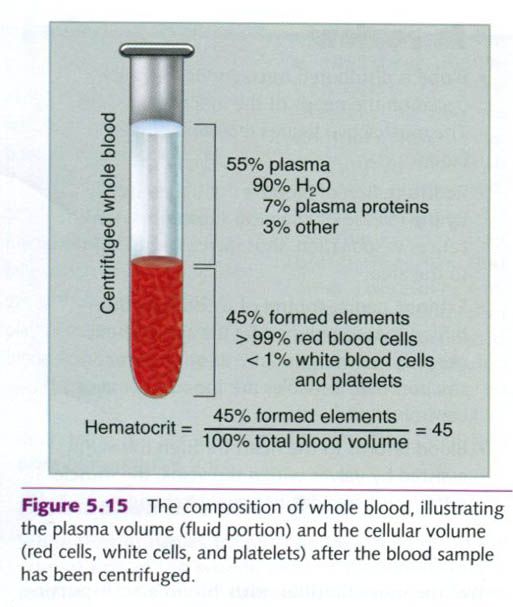- Transportation,
- Temperature regulation,
- Acid-base(pH) balance.
We are most familiar with blood’s transporting
functions. In addition, blood is critical in temperature regulation during
physical activity; it picks up heat from the exercising muscle and delivers it
to the skin where it can be dissipated to the environment. Blood also buffers
the acids produced by anaerobic metabolism and maintains proper pH for
metabolic processes.
Blood volume and composition
The
total volume of blood in the body varies considerably with an individual’s size
and state of training. Larger blood volumes are associated with greater lean
body mass and higher levels of endurance training. The blood volume of people
of average body size and normal physical activity generally ranges from 5 to 6
L in men and 4 to 5 L in women.
Blood is composed of plasma and formed
elements. Plasma normally constitutes about 55% to 60% of total blood volume
but can decrease by 10% of its normal amount or more with intense exercise in
heat, or can increase by 10% or more with endurance training or acclimation to
heat. Approximately 90% of the plasma volume is water; 7% consists of plasma
proteins; and the remaining 3% includes cellular nutrients, electrolytes,
enzymes, hormones, antibodies and wastes.
The
formed elements, which normally constitute the other 40% to 45% of total blood
volume, are the red blood cells(erythrocytes), white blood cells(leukocytes),
and platelets(thrombocytes).
Red blood cells constitute more than 99% of the formed-element volume; white
blood cells and platelets together account for less than 1%. The percentage of
the total blood volume composed of cells or formed elements is reffered to as
the hematocrit.
White blood cells protect the body from
infection either by directly destroying the invading agents through phagocytosis(ingestion)
or by forming antibodies to destroy them. Adults have about 7,000 white blood
cells per cubic millimeter of blood.
The remaining formed elements are the blood
platelets. These are cell fragments that are required for blood
coagulation(clotting), which prevents excessive blood loss. Exercise physiologists
are most concerned with red blood cells.
Red blood cells
Mature red blood cells(erythrocytes) have no
nucleus, so they cannot reproduce as other cells can. They must be replaced
with new cells on a reoccurring basis, a process called hematopoiesis.
The normal life span of a red blood cell is about four months. Thus, these
cells are continuously produced and destroyed at about equal rates. This
balance is very important, because adequate oxygen delivery to tissues depends
on having a sufficient number of red blood cells to transport oxygen. Decreases
in their number of function can hinder oxygen delivery and thus affect exercise
performance.
Red blood cells transport oxygen, which is
primarily bound to hemoglobin.
Hemoglobin is composed of a protein(globin) and a pigment(heme). Heme
contains iron, which binds oxygen. Each red blood cell contains
approximately 250 million hemoglobin molecules, each able to bind four oxygen
molecules – so each red blood cell can bind up to a billion molecules of oxygen!
There is an average of 15g of hemoglobin per 100ml of whole blood. Each gram of
hemoglobin can combine with 1.33ml of oxygen, so as much as 20ml of oxygen can
be bound for each 100ml of blood. Therefore, when arterial blood is saturated
with oxygen, it has an oxygen-carrying capacity of 20 ml of oxygen per 100ml of
blood.
Blood viscosity
Viscosity refers to the thickness of the blood.
Recall from our discussion of vascular resistance that the more vicious a
fluid, the more resistant it is to flow. The viscosity of blood is normally
about twice that of water. Blood viscosity, and thus resistance to flow,
increases with higher hematocrits.
Because of oxygen transport by the red blood
cells, an increase in their number would be expected to maximize oxygen
transport. But if an increase in red blood cell count is not accompanied by a
similar increase in plasma volume, blood viscosity and vascular resistance will
increase, which could result in reduced blood flow. This generally is not a
problem unless the hematocrit reaches 60% or more.
Conversely, the combination of a low hematocrit
with a high plasma volume, which decreases the blood’s viscosity, appears to
have certain benefits for the blood’s transport function because the blood can
flow more easily. Unfortunately, a low hematocrit frequently results from a
reduced red blood cell count, as in diseases such as anemia. Under these
circumstances, the blood can flow easily, but it contains fewer carriers, so
oxygen transport is impeded. For optimal physical performance, a low hematocrit
with a normal or slightly elevated number of red blood cells is desirable. This
combination facilitates oxygen transport. Many endurance athletes achieve this
combination as part of their cardiovascular system’s normal adaptation to
training.










1 коментара:
Great tips regrading blood volume. You provided the best information which helps us a lot. Thanks for sharing the wonderful information.
Постави коментар